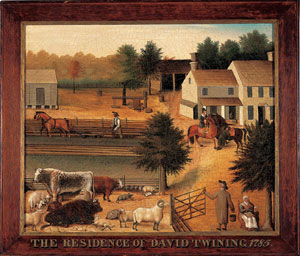3.25.24 — My Own Mark
To wrap up from last time on folk art, the American Folk Art Museum is out to add color to American art and history, people of color. With “Unnamed Figures,” through March 24, it asks how folk art drew on African Americans as artists and subjects while refusing to name names.
It shows how their absence testifies to unseen presences, while its presences testify to exclusions. In fact, it does that so well that one can almost forget what it leaves out. The show passes over conflict, the slave states, life after the Civil War, and a specifically African American art.  They appear nonetheless right next door, if only in part, with “Marvels of My Own Inventiveness“—and I bring them together with an earlier report on outsider artists as a longer review and my latest upload.
They appear nonetheless right next door, if only in part, with “Marvels of My Own Inventiveness“—and I bring them together with an earlier report on outsider artists as a longer review and my latest upload.
Each of its five artists has only a handful of works, but enough to leave a mark and a name. One can see their determination with the oldest of the five, Mary T. Smith, born in 1905. Working in the 1980s, she applies black in broad strokes, for big outlines, big egos, and big hair. Her figures face front, like the familiar icons of black power, but with colorful, casual compositions that take nothing for granted. The people themselves could just as well be nameless. They do not so much confront the theme of black invisibility as rebel against it.
By the time one reaches the youngest, Claude Lawrence, colliding colors are more than half the point. As a title puts it, Why So Blue? Born in 1944, Lawrence packs them in, not so much layered or intermixed as fighting for space. Faces appear, but an explicit politics is gone. Certainty must have given out anyway after the election of Ronald Reagan, even for Smith. That still leaves presences, if only one could pin them down.
The modest show comes as a postscript to the larger one, but also a counterpoint. The very hallmarks of the older folk art are gone, from its stiff, firm outlines to its narratives. Black artists today have often drawn on the flatness and patterning of African American art in the South or African art itself, but not here. Smith’s scrawls suggest street art and defacement, not unlike those of Jean-Michel Basquiat. Yet they avoid his deliberate clichés and aggressive juxtapositions. They leave open just what is left of outsider art other than the outsider.
The show’s awkward title adapts a line from Hortense Spillers, a literary critic who has sought an “African American grammar.” Echoes of William Butler Yeats, with art as “monuments of its own magnificence,” may be deliberate as well. The combination points to identity politics, but also shifting perspectives. J. B. Murray has a reputation as an Abstract Expressionist, which accounts for his freely detailed brush, but not much more. The tiny marks could be figures in half a dozen history paintings at once. One could almost treat its divisions as panels in a graphic novel.
Purvis Young is fond of busy marks and crude divisions, too. Wood slats overlay his paintings, like stretchers that have moved to the front or frames that refuse to close. There is a riot going on. It may or may not be race riot, and Leonard Daley depicts both blacks and whites amid a painting’s discarded materials. If a white figure looks to a livelier black figure for help, its whiteness has faded to a bright, pure, ghostly white. If the black figure is a tempter, painting has its temptations, too.
Read more, now in a feature-length article on this site.
